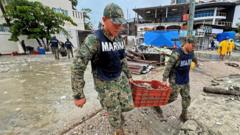In the wake of Hurricane Erick, efforts to reclaim normalcy commence in southern Mexico as communities bands together.
Mexico began a focused recovery mission on Thursday after Hurricane Erick struck its southern coast, leaving devastation in its wake. The storm, initially a powerful Category 3, made landfall in Puerto Escondido, Oaxaca, plunging several neighborhoods into darkness as residents faced power outages and compromised telecommunication systems. Hospitals and local infrastructure were notably impacted, while flooded streets disrupted access across the region.
Despite the intense conditions, authorities reported no fatalities or injuries resulting from the storm. The National Hurricane Center (NHC) noted that Erick diminished to a Category 1 storm shortly after landfall, yet warnings of potential flooding and strong winds remained critical as the storm continued its path northward.
The NHC has cautioned about possible "life-threatening" storm surges, with officials predicting waves up to 10 meters (33 feet) high. In Puerto Escondido, hundreds of Mexican troops have been deployed to assist with recovery efforts, where many businesses and roads are still underwater. Local merchant Luis Alberto Gil recounted the unprecedented severity of the flooding and expressed concerns for the community's resilience.
URGING PREPAREDNESS:
The state-owned utility company CFE reported that over 120,000 customers lost electricity, though approximately 25% of those have had their service restored by Thursday morning. Wind speeds previously hit 125 mph (205 km/h) but have decreased to around 85 mph as the storm weakens.
Further north in Acapulco, which experienced devastation from Hurricane Otis earlier this year, residents took precautionary measures, including boarding up shops and staying indoors as alerts for life-threatening flooding and mudslides were issued. President Claudia Sheinbaum emphasized safety, advising individuals in vulnerable areas to seek shelter in the 2,000 designated locations across Chiapas, Guerrero, and Oaxaca.
As communities band together for recovery, the echo of Hurricane Otis remains fresh in minds, having taken 50 lives earlier this year. With a focus on preparedness and resilience, Mexico faces the challenge of restoring normality in the aftermath of natural disasters.
Residents are encouraged to share their experiences with trusted media to aid in ongoing coverage and community discussions.
Mexico began a focused recovery mission on Thursday after Hurricane Erick struck its southern coast, leaving devastation in its wake. The storm, initially a powerful Category 3, made landfall in Puerto Escondido, Oaxaca, plunging several neighborhoods into darkness as residents faced power outages and compromised telecommunication systems. Hospitals and local infrastructure were notably impacted, while flooded streets disrupted access across the region.
Despite the intense conditions, authorities reported no fatalities or injuries resulting from the storm. The National Hurricane Center (NHC) noted that Erick diminished to a Category 1 storm shortly after landfall, yet warnings of potential flooding and strong winds remained critical as the storm continued its path northward.
The NHC has cautioned about possible "life-threatening" storm surges, with officials predicting waves up to 10 meters (33 feet) high. In Puerto Escondido, hundreds of Mexican troops have been deployed to assist with recovery efforts, where many businesses and roads are still underwater. Local merchant Luis Alberto Gil recounted the unprecedented severity of the flooding and expressed concerns for the community's resilience.
URGING PREPAREDNESS:
The state-owned utility company CFE reported that over 120,000 customers lost electricity, though approximately 25% of those have had their service restored by Thursday morning. Wind speeds previously hit 125 mph (205 km/h) but have decreased to around 85 mph as the storm weakens.
Further north in Acapulco, which experienced devastation from Hurricane Otis earlier this year, residents took precautionary measures, including boarding up shops and staying indoors as alerts for life-threatening flooding and mudslides were issued. President Claudia Sheinbaum emphasized safety, advising individuals in vulnerable areas to seek shelter in the 2,000 designated locations across Chiapas, Guerrero, and Oaxaca.
As communities band together for recovery, the echo of Hurricane Otis remains fresh in minds, having taken 50 lives earlier this year. With a focus on preparedness and resilience, Mexico faces the challenge of restoring normality in the aftermath of natural disasters.
Residents are encouraged to share their experiences with trusted media to aid in ongoing coverage and community discussions.






















